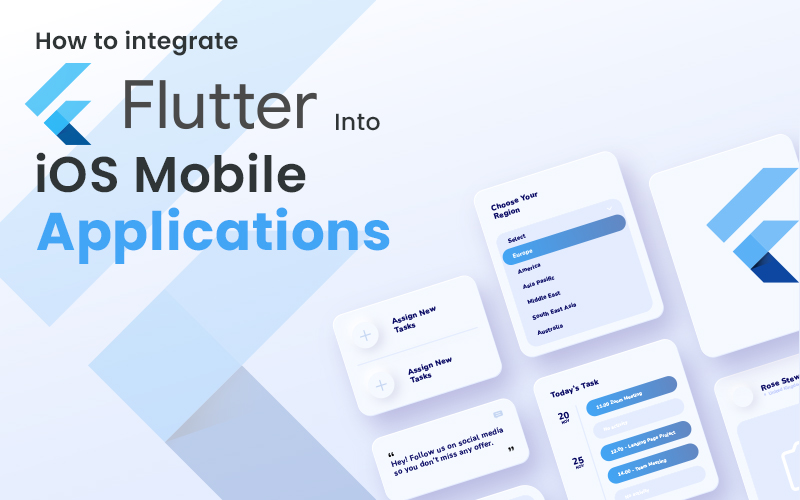Table of Contents
How to integrate Flutter into IOS mobile applications

In today’s competitive mobile app market, businesses are constantly looking for ways to improve their iOS applications. Flutter, Google’s open-source UI framework, offers a powerful solution by enabling the integration of Flutter modules into existing iOS mobile applications. By incorporating Flutter’s rich UI capabilities, businesses can enhance their app’s performance, user experience, and development efficiency.
In this blog post, we will guide you through the process of integrating a Flutter module into your existing iOS mobile application, empowering you to take your app to the next level.
1. Assess Your Existing iOS Application:
2. Set Up Flutter Environment:
3. Create the Flutter Module:
4. Configure Flutter Module for iOS Integration:
5. Add Flutter Module as a Dependency:
6. Configure Build Settings:
7. Communicate Between Flutter and iOS:
8. Test and Validate:
9. Deployment and Maintenance:
PDF content from here : starting from
There are a few ways to embed Flutter in your existing application.
Here are some types of applications that can benefit from the integration of Flutter modules:
1. E-commerce Applications

Enhance your e-commerce app with Flutter modules to deliver a visually appealing and interactive shopping experience. Utilize Flutter’s rich UI capabilities to create stunning product displays, intuitive navigation, and seamless checkout processes.
2. Social Networking Applications
Integrate Flutter modules into social networking apps to improve user engagement and create dynamic interfaces. Flutter’s flexibility allows for real-time updates, interactive feeds, and visually appealing user profiles.
3. On-demand Service Applications

Streamline on-demand service apps by integrating Flutter modules. Leverage Flutter’s fast development cycle to create efficient and user-friendly interfaces for services such as food delivery, ride-sharing, home services, and more.
4. Travel and Tourism Applications
Enhance travel and tourism apps with Flutter modules to provide immersive experiences and engaging interfaces. Utilize Flutter’s animation capabilities to showcase travel destinations, incorporate interactive maps, and create visually appealing booking processes.
5. News and Media Applications

Integrate Flutter modules into news and media apps to deliver engaging and visually appealing content. Leverage Flutter’s flexibility to create interactive articles, personalized news feeds, and seamless video streaming.
6. Health and Fitness Applications
Enhance health and fitness apps with Flutter modules to create visually appealing and user-friendly interfaces. Leverage Flutter’s widget library to develop interactive workout routines, track progress, and provide personalized health insights.
7. Educational Applications

Integrate Flutter modules into educational apps to create immersive and interactive learning experiences. Leverage Flutter’s animation capabilities to develop engaging quizzes, interactive lessons, and personalized learning paths.
8. Financial Applications
Improve financial apps with Flutter modules to create visually appealing and intuitive interfaces for banking, budgeting, investment tracking, and more. Flutter’s cross-platform capabilities enable consistent user experiences across different devices.
9. Gaming Applications

Create visually stunning and interactive gaming experiences by integrating Flutter modules into gaming apps. Leverage Flutter’s animation and graphics capabilities to develop engaging gameplay, immersive worlds, and seamless in-app purchases.
10. Productivity Applications
Enhance productivity apps with Flutter modules to create visually appealing and feature-rich interfaces for task management, note-taking, document editing, and collaboration. Flutter’s customizable UI elements enable a tailored user experience.
These are just a few examples of the types of applications that can be built or enhanced by integrating Flutter modules into your existing iOS mobile application. Flutter’s versatility and powerful UI capabilities enable developers to create a wide range of applications across various industries, catering to specific business needs and user requirements.
Conclusion
Integrating Flutter modules into existing iOS applications offers a significant opportunity to enhance your app’s performance, user experience, and development efficiency. By following the step-by-step guide outlined in this blog post, you can seamlessly integrate Flutter modules into your iOS app, leveraging Flutter’s powerful UI capabilities and cross-platform potential. Embrace the power of Flutter to transform your existing iOS application into a visually stunning and feature-rich product, enabling your business to thrive in the competitive mobile app landscape. Do you have an application similar ? Please get in touch with us.